Tokhme khar
BANNED

- Joined
- Feb 25, 2017
- Messages
- 2,507
- Reaction score
- -10
- Country
- Location
Zoroastrian village comes to life for ancient winter festival
#Religion
Every year in late January, Iranian Zoroastrians celebrate the passing of winter by kindling bonfires in temples scattered across the country

A group of non-Zoroastrian girls dance around the fire (MEE/Changiz M Varsi)

Changiz M. Varzi
Friday 5 February 2016 11:00 UTC
Last update:
Friday 5 February 2016 13:25 UTC
Topics:
Religion
Tags:
Iran, Zoroastrianism, religion
Show comments
Only three families live under old thatched-roof houses in the small village of Cham. A dusty narrow road runs through the middle of the village and past the pomegranate gardens.
The village is located in the Yazd province, in central Iran, between the two big deserts of Dasht-e Loot, one of the largest and driest deserts on earth, and the immense and largely uninhabitable salt desert of Dasht-e Kavir.
 One of the many abandoned houses of the Zoroastrian village of Cham in central Iran (MEE/Changiz M Varzi)
One of the many abandoned houses of the Zoroastrian village of Cham in central Iran (MEE/Changiz M Varzi)
The six inhabitants of this Zoroastrian village are all elderly. Their children migrated to the eastern city of Yazd, and to the western town of Taft in the hope of finding a job and making a better life for themselves. The luckier ones made their ways to the capital Tehran, about 650 kilometres to the north.
Cham’s by-road, which splits from the Yazd-Taft motorway, passes a tiny building on a hillside. Pir-e Rahgozar is the only place that brings life to the village, although this happens just once a year. Pir-e Rahgozar is the temple where Zoroastrians gather on Bahman 10 (30 or 31 January) to celebrate the ancient Sadeh Festival.
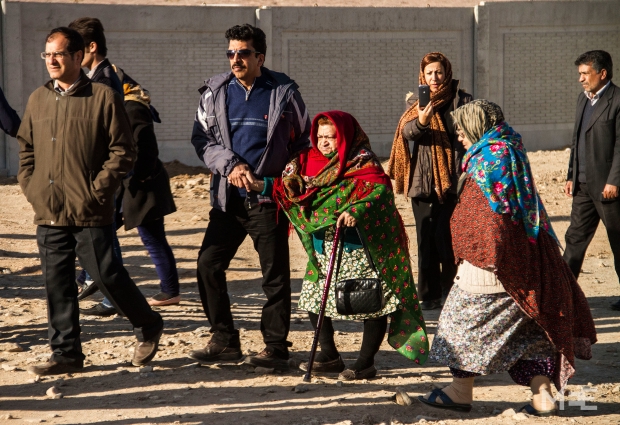 An elderly Zoroastrian lady from the city of Yazd attends the ceremony in Cham (MEE/Changiz M Varzi)
An elderly Zoroastrian lady from the city of Yazd attends the ceremony in Cham (MEE/Changiz M Varzi)
The origins of the festival are not clear and there is no trace of this ceremony in Zoroastrian holy texts. Some historians suggest this ceremony existed even before Zoroastrianism, the world's oldest monotheistic religion.
Despite the scholarly debate, the common belief is that Sadeh is a Zoroastrian mid-winter ritual to celebrate the date that the weather starts warming up, 100 days and 100 nights into winter. “This ceremony is to celebrate the time that the earth becomes warm from inside, and we burn fire to defeat the forces of coldness and the dark,” said Farzin Pour-rostam, a Zoroastrian priest participating in the ceremony.
 Zoroastrians pray inside the Pir-e Rahgozar temple. (MEE/Changiz M Varsi)
Zoroastrians pray inside the Pir-e Rahgozar temple. (MEE/Changiz M Varsi)
Some mythological accounts connect the festival to the origins of humans. According to Persian mythology, Houshang, the second king of the world, discovered fire when he tried to hit a dragon with a stone. He reportedly threw a flint stone which struck against another flint stone causing a spark and generating fire.
Some people believe the feast is to celebrate that mythical discovery of fire and that is why Zoroastrian priests set fire to a big pile of wood at the climax of the ceremony.
 Shina Sardady, a Zoroastrian artist, tells the myth of the discovery of fire from the tradition of Naghaly. This type of stage art is the Iranian traditional solo performance of epics and old stories (MEE/Changiz M. Varzi)
Shina Sardady, a Zoroastrian artist, tells the myth of the discovery of fire from the tradition of Naghaly. This type of stage art is the Iranian traditional solo performance of epics and old stories (MEE/Changiz M. Varzi)
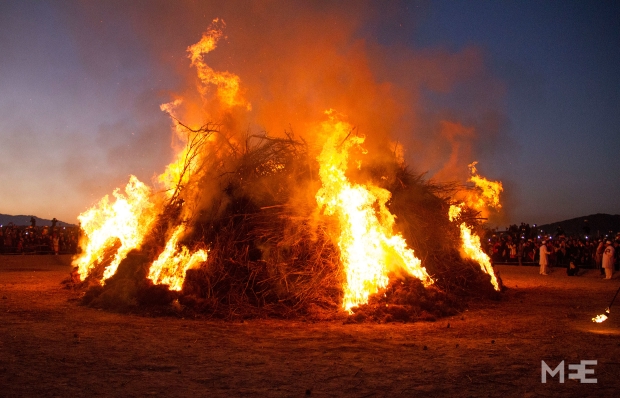 As the last rays of the setting sun disappear, the Zoroastrians’ fire grows higher (MEE/Changiz M. Varzi)
As the last rays of the setting sun disappear, the Zoroastrians’ fire grows higher (MEE/Changiz M. Varzi)
In Cham, the followers of Zoroaster are not the only attendees of the ceremony, nor are they just from the surrounding cities of Yazd or Taft. In recent years, domestic tourists or those who are interested in Zoroastrianism have come from across the country to celebrate Sadeh in Cham. This year, about 4,000 people joined the festival.
Fatemeh Ali-Ahmady, a 46-year-old Muslim architect, came from Tehran to attend the ceremony and visit the central cities of Yazd and Kerman. According to her, the festival is not just a Zoroastrian ritual, but “an ancient Persian ceremony that belongs to all Iranians”.
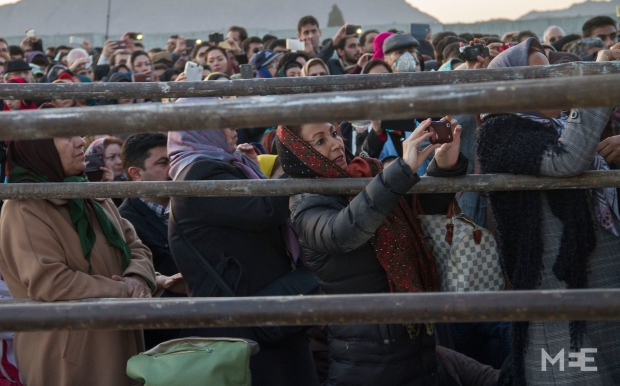 Approximately 4000 people are estimated to have attended the Sadeh festival this year, with the number of non-Zoroastrian attendees believed to also be increasing (MEE/Changiz M. Varzi)
Approximately 4000 people are estimated to have attended the Sadeh festival this year, with the number of non-Zoroastrian attendees believed to also be increasing (MEE/Changiz M. Varzi)
This is not Ali-Ahmady’s first time celebrating Sadeh. In previous years, she participated in the ceremony in Tehran and Kerman. “Even though I practise Islam, I am interested to learn more about Zoroastrianism as this was our ancestral religion before Islam,” she says, referring to the Arabs’ conquest of Iran in the seventh century.
From 600 BC to 650 AC, Zoroastrianism was the official religion of the Persian Empire. When the Arabs brought the Persian Empire to its knees at the end of the Sassanid dynasty, most Zoroastrians converted to Islam. A few of them escaped to India, and the smallest group stayed in Iran and preserved their faith. The current number of Zoroastrians in Iran is estimated to be about 25,000, according to the Statistical Centre of Iran.
 Two Zoroastrian girls read the sacred hymns of Gata out loud in the old Farsi language and translate it into modern Farsi for the participants (MEE/Changiz M. Varzi)
Two Zoroastrian girls read the sacred hymns of Gata out loud in the old Farsi language and translate it into modern Farsi for the participants (MEE/Changiz M. Varzi)
Although Zoroastrians are few in number, their rituals are widespread in Iran. Nowruz, which celebrates the Persian New Year in March, the Yalda Festival, which takes place on the longest night of the year, and Chaharshanbeh Souri, in praise of the spring, are examples of Zoroastrian ceremonies that all Iranians celebrate publicly.
Sadeh is a little different to some of those other ceremonies though. “Even though non-Zoroastrians join us for the ceremony, Sadeh is not well-known among all Iranians,” Shapour Pishdad, a Zoroastrian from Yazd told Middle East Eye. “Sadeh is not as common as Nowruz or Yalda, and Zoroastrians are the only people who officially celebrate the festival in their temples, houses and places of worship.”
For the ceremony, before the sacred ritual of lighting the fire, six Zoroastrian priests read out loud from Avesta, the holy book of Zoroastrians. The priests are always dressed in white cotton robes, white trousers and white hats as a sign of purity and neatness.
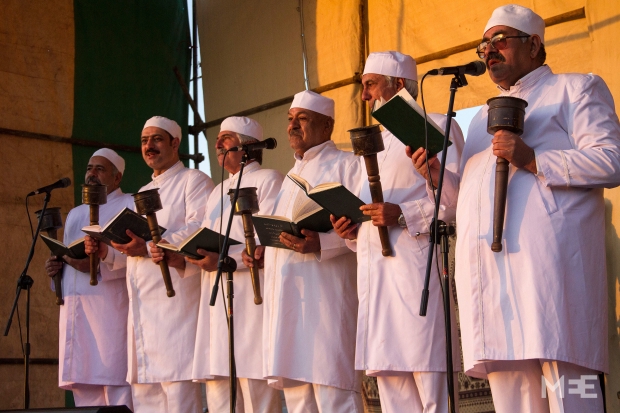 Zoroastrian priests perform the last religious part of the ceremony by reciting Avesta, the holy scripture of Zoroastrianism (MEE/Changiz M. Varzi)
Zoroastrian priests perform the last religious part of the ceremony by reciting Avesta, the holy scripture of Zoroastrianism (MEE/Changiz M. Varzi)
Inside the small praying room of Pir-e Rahgozar, the celebrants recite religious hymns in the ancient Persian language. The smell of burning incense sticks fills the room, and a tiny fire flickers in an urn. Fire is an important element in this religion and a symbol of purity and truth.
Outside the room, Zoroastrian girls in white dresses and headscarves play Daf, an Iranian traditional instrument, and wait for the last ritual of the ceremony.
Six priests along with six young Zoroastrian girls, all dressed in white and holding torches, leave the temple. They walk around the pyre from right to left. The crowd draws closer to see the first moment of the blaze and as the fire becomes larger, the crowd’s cheers grow louder. This is the climax of the feast.
 The Daf players walk around the pile of shrubs (MEE/Changiz M. Varzi)
The Daf players walk around the pile of shrubs (MEE/Changiz M. Varzi)
Despite the wide acceptance of Zoroastrianism in Iran, not all Iranians are as positive about the followers of this religion. The driver of the night bus from Yazd to Tehran was surprised when he learned about the people who make a trip from the capital to participate in the Sadeh ceremony in Cham.
“You must be so bored in Tehran, or you should absolutely have nothing else to do, to come here for Sadeh,” the bus driver said. “Zoroastrians are not like us, they don’t believe in God, they worship fire.”
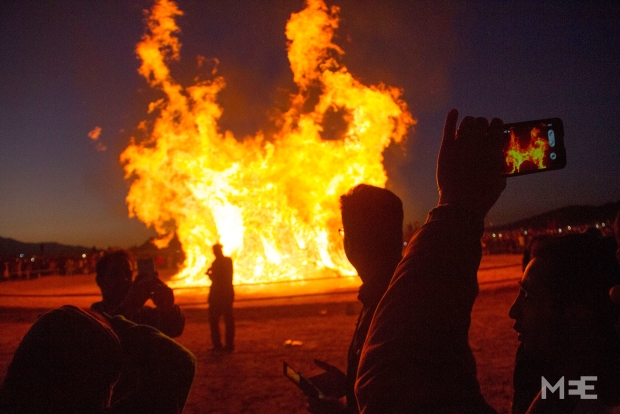
The Sadeh festival lasts about three hours and ends with lighting the fire (MEE/Changiz M. Varzi)
https://www.middleeasteye.net/in-de...rt-iran-zoroastrians-ancient-feast-1789877481
#Religion
Every year in late January, Iranian Zoroastrians celebrate the passing of winter by kindling bonfires in temples scattered across the country

A group of non-Zoroastrian girls dance around the fire (MEE/Changiz M Varsi)

Changiz M. Varzi
Friday 5 February 2016 11:00 UTC
Last update:
Friday 5 February 2016 13:25 UTC
Topics:
Religion
Tags:
Iran, Zoroastrianism, religion
Show comments
Only three families live under old thatched-roof houses in the small village of Cham. A dusty narrow road runs through the middle of the village and past the pomegranate gardens.
The village is located in the Yazd province, in central Iran, between the two big deserts of Dasht-e Loot, one of the largest and driest deserts on earth, and the immense and largely uninhabitable salt desert of Dasht-e Kavir.

The six inhabitants of this Zoroastrian village are all elderly. Their children migrated to the eastern city of Yazd, and to the western town of Taft in the hope of finding a job and making a better life for themselves. The luckier ones made their ways to the capital Tehran, about 650 kilometres to the north.
Cham’s by-road, which splits from the Yazd-Taft motorway, passes a tiny building on a hillside. Pir-e Rahgozar is the only place that brings life to the village, although this happens just once a year. Pir-e Rahgozar is the temple where Zoroastrians gather on Bahman 10 (30 or 31 January) to celebrate the ancient Sadeh Festival.

The origins of the festival are not clear and there is no trace of this ceremony in Zoroastrian holy texts. Some historians suggest this ceremony existed even before Zoroastrianism, the world's oldest monotheistic religion.
Despite the scholarly debate, the common belief is that Sadeh is a Zoroastrian mid-winter ritual to celebrate the date that the weather starts warming up, 100 days and 100 nights into winter. “This ceremony is to celebrate the time that the earth becomes warm from inside, and we burn fire to defeat the forces of coldness and the dark,” said Farzin Pour-rostam, a Zoroastrian priest participating in the ceremony.

Some mythological accounts connect the festival to the origins of humans. According to Persian mythology, Houshang, the second king of the world, discovered fire when he tried to hit a dragon with a stone. He reportedly threw a flint stone which struck against another flint stone causing a spark and generating fire.
Some people believe the feast is to celebrate that mythical discovery of fire and that is why Zoroastrian priests set fire to a big pile of wood at the climax of the ceremony.


In Cham, the followers of Zoroaster are not the only attendees of the ceremony, nor are they just from the surrounding cities of Yazd or Taft. In recent years, domestic tourists or those who are interested in Zoroastrianism have come from across the country to celebrate Sadeh in Cham. This year, about 4,000 people joined the festival.
Fatemeh Ali-Ahmady, a 46-year-old Muslim architect, came from Tehran to attend the ceremony and visit the central cities of Yazd and Kerman. According to her, the festival is not just a Zoroastrian ritual, but “an ancient Persian ceremony that belongs to all Iranians”.

This is not Ali-Ahmady’s first time celebrating Sadeh. In previous years, she participated in the ceremony in Tehran and Kerman. “Even though I practise Islam, I am interested to learn more about Zoroastrianism as this was our ancestral religion before Islam,” she says, referring to the Arabs’ conquest of Iran in the seventh century.
From 600 BC to 650 AC, Zoroastrianism was the official religion of the Persian Empire. When the Arabs brought the Persian Empire to its knees at the end of the Sassanid dynasty, most Zoroastrians converted to Islam. A few of them escaped to India, and the smallest group stayed in Iran and preserved their faith. The current number of Zoroastrians in Iran is estimated to be about 25,000, according to the Statistical Centre of Iran.

Although Zoroastrians are few in number, their rituals are widespread in Iran. Nowruz, which celebrates the Persian New Year in March, the Yalda Festival, which takes place on the longest night of the year, and Chaharshanbeh Souri, in praise of the spring, are examples of Zoroastrian ceremonies that all Iranians celebrate publicly.
Sadeh is a little different to some of those other ceremonies though. “Even though non-Zoroastrians join us for the ceremony, Sadeh is not well-known among all Iranians,” Shapour Pishdad, a Zoroastrian from Yazd told Middle East Eye. “Sadeh is not as common as Nowruz or Yalda, and Zoroastrians are the only people who officially celebrate the festival in their temples, houses and places of worship.”
For the ceremony, before the sacred ritual of lighting the fire, six Zoroastrian priests read out loud from Avesta, the holy book of Zoroastrians. The priests are always dressed in white cotton robes, white trousers and white hats as a sign of purity and neatness.

Inside the small praying room of Pir-e Rahgozar, the celebrants recite religious hymns in the ancient Persian language. The smell of burning incense sticks fills the room, and a tiny fire flickers in an urn. Fire is an important element in this religion and a symbol of purity and truth.
Outside the room, Zoroastrian girls in white dresses and headscarves play Daf, an Iranian traditional instrument, and wait for the last ritual of the ceremony.
Six priests along with six young Zoroastrian girls, all dressed in white and holding torches, leave the temple. They walk around the pyre from right to left. The crowd draws closer to see the first moment of the blaze and as the fire becomes larger, the crowd’s cheers grow louder. This is the climax of the feast.

Despite the wide acceptance of Zoroastrianism in Iran, not all Iranians are as positive about the followers of this religion. The driver of the night bus from Yazd to Tehran was surprised when he learned about the people who make a trip from the capital to participate in the Sadeh ceremony in Cham.
“You must be so bored in Tehran, or you should absolutely have nothing else to do, to come here for Sadeh,” the bus driver said. “Zoroastrians are not like us, they don’t believe in God, they worship fire.”

The Sadeh festival lasts about three hours and ends with lighting the fire (MEE/Changiz M. Varzi)
https://www.middleeasteye.net/in-de...rt-iran-zoroastrians-ancient-feast-1789877481





